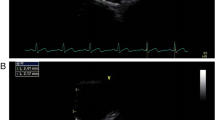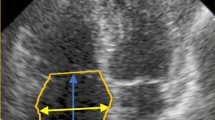Abstract
As the number of implanted biventricular pacemakers increases, the coronary sinus (CS) has evoked much interest amongst cardiologists. A dilated CS could prompt the existence of many diseases. The normal CS diameter is uncertain, especially in children. A total of 446 Chinese healthy children were prospectively enrolled in this study. The superior and inferior diameter of the CS was measured from the CS ostium 1 cm from the end of ventricular systole in the modified apical 4-chamber view. Seven models were tested to determine the relationships between parameters of body size and CS diameter. Heteroscedasticity was tested by the White and Breusch–Pagan tests. A multiple linear regression model should be gender as a covariate along with BSAStevenson, in order to evaluate the influence of gender on the measurements. The formula of Stevenson was best-fit. The predicted values and Z-score boundaries for measurement of the CS diameter were calculated. Bland–Altman plot regression showed that the 95 % limits of agreement for inter- and intra-observer measurements were not significantly different. We report new, reliable echocardiographic Z scores for the CS diameter derived from a large population of healthy Chinese children. The Z scores can be used in echocardiographic examinations.





Similar content being viewed by others
References
D’Cruz IA, Shala MB, Johns C (2000) Echocardiography of the coronary sinus in adults. Clin Cardiol 23:149–154
Katre R, Burns SK, Murillo H, Lane MJ, Restrepo CS (2012) Anomalous pulmonary venous connections. Semin Ultrasound CT MR 33:485–499
Xie MX, Yang YL, Cheng TO, Wang XF, Li K, Ren PP, Lü Q, Lin H, Li L (2013) Coronary sinus septal defect (unroofed coronary sinus): echocardiographic diagnosis and surgical treatment. Int J Cardiol 168:1258–1263
Kronzon I, Tunick PA, Jortner R, Drenger B, Katz ES, Bernstein N, Chintiz LA, Freedberg RS (1995) Echocardiographic evaluation of the coronary sinus. J Am Soc Echocardiogr 8:518–526
Dallaire F, Dahdah N (2011) New equations and a critical appraisal of coronary artery Z score in healthy children. J Am Soc Echocardiogr 24:60–74
World Health Organization. The WHO child growth standards. http://www.who.int/childgrowth/en. Accessed 26 Aug 2014
Centers for Disease Control and Prevention. Growth charts. http://www.cdc.gov/growthcharts. Accessed 26 Aug 2014
Lopez L, Colan SD, Frommelt PC, Ensing GJ, Kendall K, Younoszai AK, Lai WW, Geva T (2010) Recommendations for quantification methods during the performance of a pediatric echocardiogram: a report from the pediatric measurements writing group of the American Society of Echocardiography Pediatric and Congenital Heart Disease Council. J Am Soc Echocardiogr 23:465–495
Ezhumalai B, Satheesh S, Anantha A, Pakkirisamy G, Balachander J, Selvaraj RJ (2014) Coronary sinus diameter by echocardiography to differentiate atrioventricular nodal reentrant tachycardia from atrioventricular reentrant tachycardia. Cardiol J 21:273–278
DuBois D, DuBois EF (1916) A formula to estimate the approximate suface area if height and weight be known. Arch Intern Med 17:863–871
Dreyer G, Ray W (1912) Further experiments upon the blood volume of mammals and its relation to the surface area of the body. Phil Trans R Soc Lond 202:191–212.
Boyd E (1935) The growth of the surface area of the human body. Greenwood, Westport
Haycock GB, Schwartz GJ, Wisotsky DH (1978) Geometric method for measuring body surface area: a height-weight formula validated in infants, children, and adults. J Pediatr 93:62–66
Mosteller RD (1987) Simplified calculation of body surface area. New Engl J Med 317:1098
Gehan EA, George SL (1970) Estimation of human body surface area from height and weight. Cancer Chemother Rep 54:225–235
Stevenson PH (1937) Height-weight-surface formula for the estimation of surface area in Chinese subjects. Chin J Physiol 3:327–330
Cantinotti M, Scalese M, Murzi B, Assanta N, Spadoni I, Festa P, De Lucia V, Crocetti M, Marotta M, Molinaro S, Lopez L, Iervasi G (2014) Echocardiographic nomograms for ventricular, valvular and arterial dimensions in caucasian children with a special focus on neonates, infants and toddlers. J Am Soc Echocardiogr 27(179–191):e2
Kim KY, Kim DS (2016) Recent advances in Kawasaki disease. Yonsei Med J 57:15–21
Cantinotti M, Lopez L (2013) Nomograms for blood flow and tissue Doppler velocities to evaluate diastolic function in children: a critical review. J Am Soc Echocardiogr 26:126–141
Cantinotti M, Scalese M, Molinaro S, Murzi B, Passino C (2012) Limitations of current echocardiographic nomograms for left ventricular, valvular, and arterial dimensions in children: a critical review. J Am Soc Echocardiogr 25:142–152
Mawad W, Drolet C, Dahdah N, Dallaire F (2013) A review and critique of the statistical methods used to generate reference values in pediatric echocardiography. J Am Soc Echocardiogr 26:29–37
Sluysmans T, Colan SD (2005) Theoretical and empirical derivation of cardiovascular allometric relationships in children. J Appl Physiol 99:445–457
Verbraecken J, Van de Heyning P, De Backer W, Van Gaal L (2006) Body surface area in normal-weight, overweight, and obese adults. A comparison study. Metabolism 55:515–524
Yu C-Y, Yu-Hung L, Chiou W-K (2003) The 3D scanner for measuring body surface area: a simplified calculation in the Chinese adult. Appl Ergon 34:273–278
Gautier M, Detaint D, Fermanian C, Aegerter P, Delorme G, Arnoult F, Arnoult F, Milleron O, Raoux F, Stheneur C, Boileau C, Vahanian A, Jondeau G (2010) Nomograms for aortic root diameters in children using two-dimensional echocardiography. Am J Cardiol 105:888–894
Cantinotti M, Scalese M, Murzi B, Assanta N, Spadoni I, De Lucia V, Crocetti M, Cresti A, Gallotta M, Marotta M, Tyack K, Molinaro S, Iervasi G (2014) Echocardiographic nomograms for chamber diameters and areas in Caucasian children. J Am Soc Echocardiogr 27:1279–1292
Gunes Y, Guntekin U, Tuncer M, Kaya Y, Akyol A (2008) Association of coronary sinus diameter with pulmonary hypertension. Echocardiography 25:935–940
Cantinotti M, Kutty S, Giordano R, Assanta N, Murzi B, Crocetti M, Marotta M, Iervasi G (2015) Review and status report of pediatric left ventricular systolic strain and strain rate nomograms. Heart Fail Rev 20:601–612
Cantinotti M, Assanta N, Crocetti M, Marotta M, Murzi B, Iervasi G (2014) Limitations of current nomograms in pediatric echocardiography: just the tip of the iceberg—a call for standardization. J Am Soc Echocardiogr 27:339
Author information
Authors and Affiliations
Corresponding author
Ethics declarations
Conflict of interest
The authors have no conflicts of interest.
Rights and permissions
About this article
Cite this article
Song, G., Liu, J., Qiao, W. et al. Regression equations of Z score and echocardiographic nomograms for coronary sinus in healthy children. Int J Cardiovasc Imaging 32, 1687–1695 (2016). https://doi.org/10.1007/s10554-016-0960-7
Received:
Accepted:
Published:
Issue Date:
DOI: https://doi.org/10.1007/s10554-016-0960-7




